Resource Management in Agile, Hybrid and Waterfall projects: key elements and best practices

It doesn’t matter if the project is worked with Agile, Waterfall or a combination of both methodologies. Without effective resource management, your projects are unlikely to succeed. However, as organizations have incorporated Agile practices into their traditional management methods, resource management has become an even more complex challenge.
In this post, we will analyze the main differences between Resource Management in Agile and Waterfall projects. We will also address the main challenges faced by PMOs and project managers in hybrid management environments. And finally, we will share best practices for optimizing resource allocation in a multi-project environment.
Resource Management in Hybrid portfolio management environments
More and more organizations are managing their projects with hybrid approaches. In today’s competitive environment, this approach can be very useful in organizations that manage multiple projects and products with different requirements, deadlines and degrees of uncertainty.
The goal is to combine the elements of Agile and Waterfall to leverage the strengths of both methodologies.
- Waterfall provides a structured framework with clear and predictable milestones.
- Agile, on the other hand, allows teams to adapt quickly to change and focus on continuous value delivery.

RESOURCE MANAGEMENT
Achieve excellence in Project Portfolio Management
Unify your Agile, Waterfall & Hybrid projects with Triskell’s PPM solutions.
Challenges of Resource Management in hybrid environments
In this situation of continuous search for balance between the flexibility of Agile and the planning of Waterfall, there are significant challenges in terms of resource management. These are the most prominent ones:
- Different work pace: Agile operates in short operational cycles (sprints), while Waterfall follows a linear, predefined schedule. Synchronizing the two approaches can lead to conflicts, especially if Agile and Waterfall teams are mutually dependent on each other’s deliverables.
- Resource allocation conflicts: In a hybrid project management environment, resources often need to be shared between Agile and Waterfall projects. This can lead to resource allocation conflicts, as project priorities and timelines can differ significantly.
- Planning and visibility: In Waterfall, planning is immovable. And, in case of variations, these are managed through a well-documented change control. In Agile, on the other hand, planning is continuous and adaptive. This can make resource planning and tracking more complex, especially in projects where both management approaches are present.
- Coordination and communication: maintaining constant communication between teams operating with different methodologies is vital to avoid misunderstandings and disagreements. Having a communication strategy is vital to avoid delays, errors or inefficient allocation of resources.
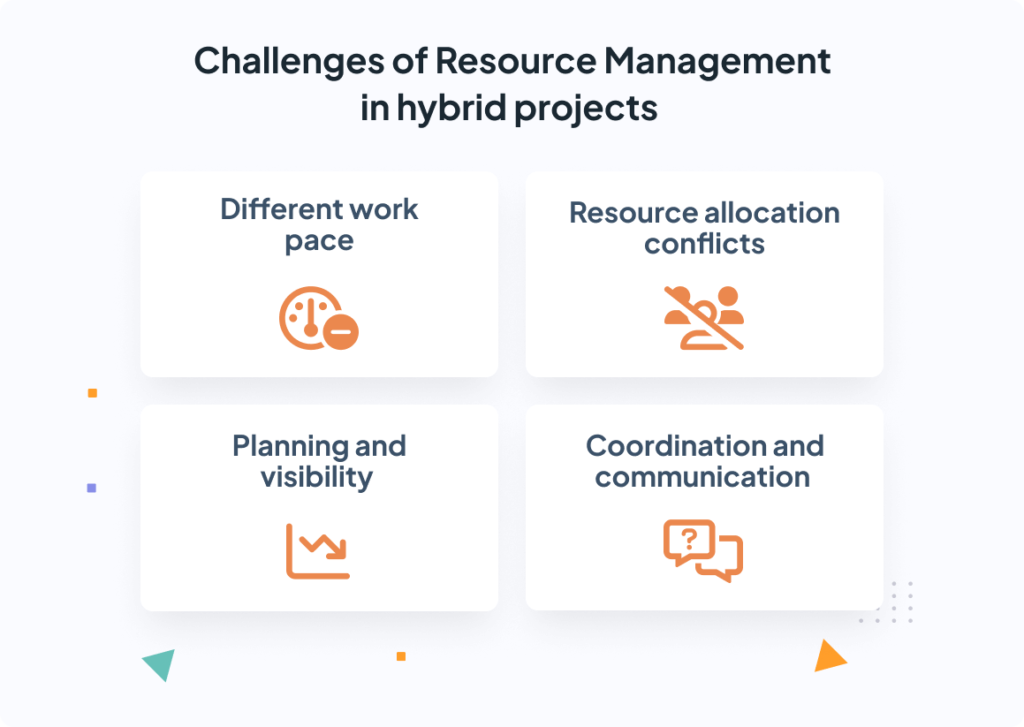
To address these challenges, it is necessary to understand in detail the nature of Agile and Waterfall methodologies. And, from there, develop a resource management strategy that is:
- Flexible enough to adapt to any methodology.
- And also robust enough to ensure the correct management of your organization’s project and product portfolios.
Let’s then break down in detail the key elements of Resource Management in Agile and Waterfall projects and the challenges that each methodology implies.
SUBSCRIBE TO OUR NEWSLETTER
Get stories like this in your inbox
Resource Management in Agile projects: key elements and techniques
Agile is based on the 12 principles set out in the Agile Manifesto, which prioritize rapid and continuous delivery of value to the customer, collaboration across teams, and responsiveness to change. These Agile principles have a significant impact on Resource Management:
- Iteration and adaptability: Agile projects are developed in sprints, in which work is prioritized according to the value it brings to the customer. This flexibility of Agile means that resources must be continually adjusted according to changing priorities.
- Self-organized and multidisciplinary teams: In Agile, teams are usually small, cross-functional and self-organized. Therefore, resources must not only be experts in their areas, but must be able to take on multiple roles and work autonomously.
- Constant collaboration with stakeholders: Agile encourages constant stakeholder involvement throughout the project and product lifecycle. This implies a more dynamic resource management, where changes in customer priorities may require a redistribution of teams and their tasks.
- Continuous value delivery: In Agile projects, incremental value delivery forces a dynamic approach to resource allocation to ensure that teams are always ready to deliver a functional product at the end of each sprint.
Master your resources across Agile and Waterfall Projects
Stop juggling spreadsheets! Get a free demo of Triskell and see how to streamline resource management for peak performance of project and product portfolios.
Agile Resource Management techniques
Therefore, Resource Management in purely Agile initiatives and tasks requires techniques that support the flexibility, collaboration and self-organization that the Agile Manifesto boasts.
These are the most recommended Agile Resource Management techniques:
- Resource allocation based on skills and capacity: Instead of assigning resources to specific long-term tasks, in Agile they should be allocated based on their capacity and skills to meet the objectives of each sprint. This way, you can adjust resource allocation quickly as needed.
- Capacity management: Agile project leaders must continuously monitor the capacity of their teams. They must ensure that they are not overloaded, and that there is sufficient capacity to respond to unexpected changes.
- Kanban and Scrum boards: both tools help manage workflow and resource allocation. They give you insights into what tasks are in progress, what is blocked and who is working on what.
- Sprint retrospectives: you should use retrospective meetings not only to analyze what worked well and what didn’t in that sprint, but also to adjust the resource management strategy for future sprints.
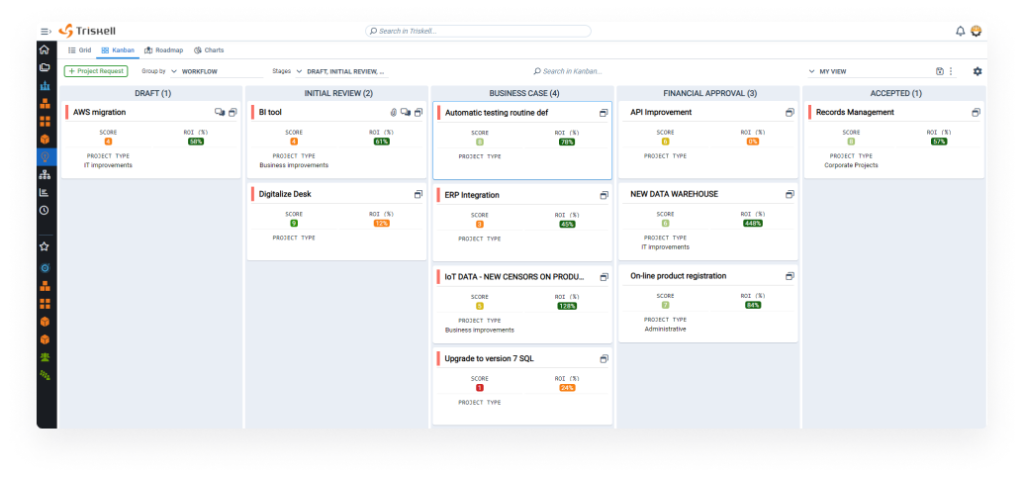
Challenges in Agile Resource Management
There is no such thing as perfection. And Agile is no exception. Agile is not for everyone. Agile projects present, in terms of resource management, a series of challenges that not all organizations are prepared to face successfully.
These are the most common challenges when managing resources in Agile projects:
- Long-term forecasting and planning: Because Agile focuses on adaptability and short iterations, long-term resource planning can be difficult, which complicates forecasting future needs.
- Conflicting priorities: it is very common for conflicts to arise when allocating resources, especially when several projects or sprints ‘compete’ for the same staff.
- Balancing workloads: ensuring that teams are not overloaded and maintain a sustainable pace of work is a constant challenge in Agile, where demands can fluctuate rapidly.
- External dependencies: Agile projects can be affected by external dependencies, especially if they are key external partners whose work methodology is not aligned with the iterative approach of Agile teams.
Resource Management in Waterfall projects
Unlike the iterative and incremental approach of Agile methodologies, Waterfall takes a sequential and linear approach to project management. It is a rigid approach that focuses on planning and the definition of roles, responsibilities and schedules.
All this makes Resource Management in this type of project have some very distinct characteristics:
- Detailed and predictable planning: unlike in Agile, in Waterfall, the use of resources is planned at the beginning of each project. This includes allocating resources for each project phase.
- Defined roles and responsibilities: Waterfall is characterized by a hierarchical structure with clearly defined roles and responsibilities. Consequently, resource allocation is less subject to unforeseen changes.
- Change control and risk management: In Waterfall, changes in resource allocation must be managed through a rigorous change control process. This brings stability, but also rigidity, to resource management.
Waterfall Resource Planning techniques
In a traditional project, resources are planned to ensure that each phase of the project is completed on time and within budget. Some resource planning techniques include:
- Gantt charts: this tool helps you visualize the sequence of activities and the allocation of resources in projects over time. It provides a clear map of how resources should be used in each project phase.
- Critical Path Method (CPM): identifying the critical path of a project allows Project Managers to concentrate resources on the key tasks that determine the overall project duration, minimizing delays.
- Responsibility Matrix: also called RACI, it helps to clarify who is responsible for which task, who should approve decisions, and who should be consulted or informed.
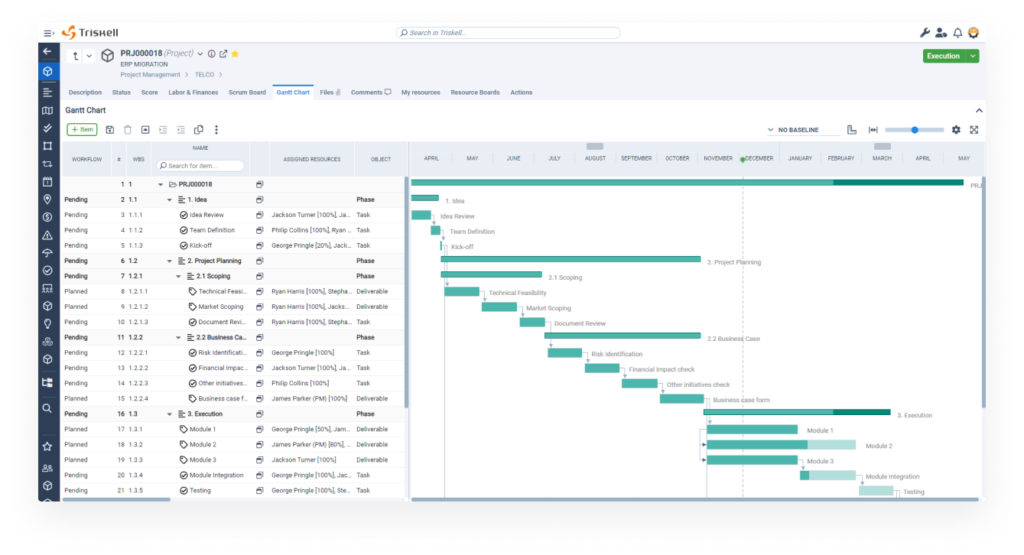
Challenges in Waterfall Resource Management
In such a fast-paced and change-prone business environment, the rigidity and structure of Waterfall is a major challenge when managing projects with this methodology. This also affects resource management.
These are the main challenges of Resource Management in Waterfall projects today:
- Inflexibility to change: once resources are allocated, making changes can be costly and problematic, especially if project requirements change during execution.
- Functional silos: Waterfall’s hierarchical structure can lead to organizational silos, where teams work in isolation. This can make it difficult to reallocate resources between different phases or projects.
- Dependencies and roadblocks: if one phase is delayed, the entire project can be affected, which can cause inefficiencies in resource utilization.
- Constant visibility and monitoring: although Waterfall facilitates long-term planning, tracking the effectiveness of resource allocation can be complex, as most decisions are made in the early phases of projects.
7 Best practices to effectively manage resources in a hybrid environment with multiple projects
In hybrid environments, where Agile and Waterfall methodologies coexist and intertwine, resource management takes on considerable complexity. It is not just a matter of managing time and tasks, but of finding a delicate balance to optimize the use of available resources, maximizing value for the organization without sacrificing quality or responsiveness.
Below, we explore in detail seven best practices that you can put in place to ensure efficient, balanced and sustainable resource allocation in a hybrid multi-project environment.
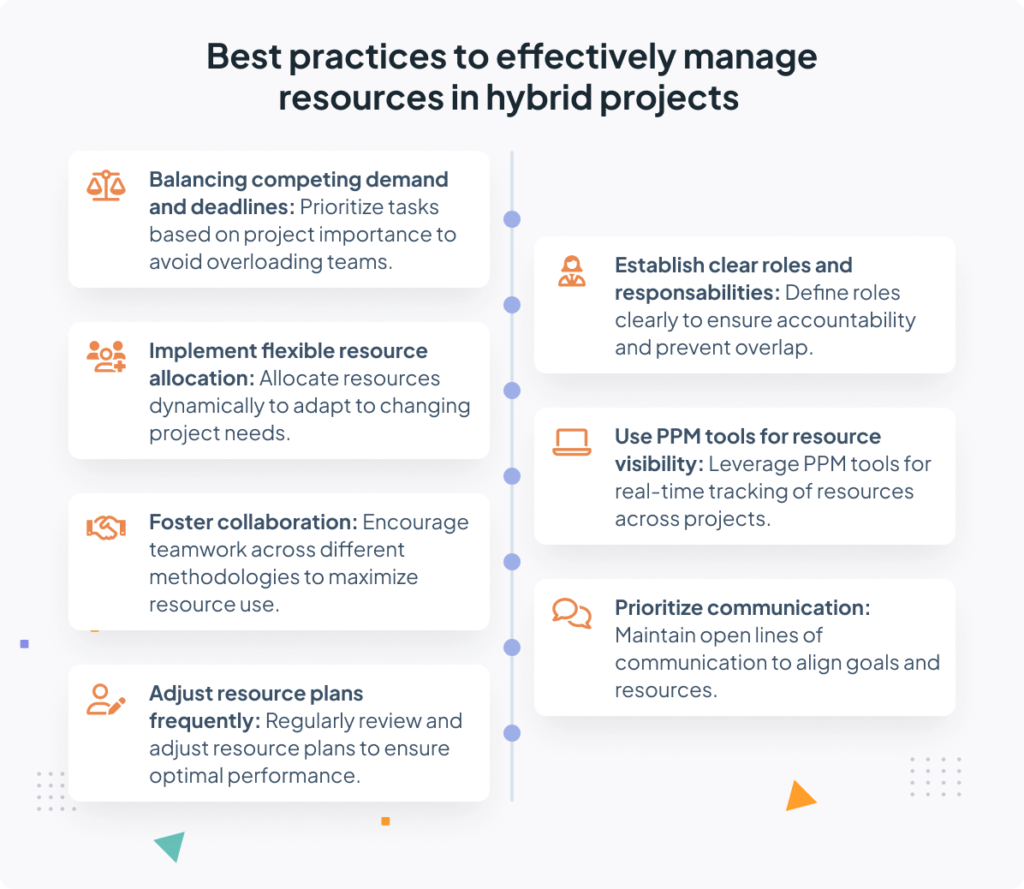
1. Balancing competing demands and deadlines
As an organization’s project and product portfolios grow larger, balancing conflicting demands and deadlines can be challenging, especially in a hybrid management environment.
Agile and Waterfall projects often have different dynamics, paces and expectations, which can lead to tensions when resources are shared between the two. Here are some strategies for balancing demands and deadlines that you can follow to minimize conflict.
- Business value assessment: In a hybrid project management environment, it is crucial to prioritize projects and tasks based on their impact on the business. Therefore, techniques such as the prioritization matrix (urgent vs. important) or weighted value analysis can help you identify which initiatives should receive priority resources.
- Proactive and reactive planning: while Waterfall relies on detailed, long-term planning, Agile requires continuous planning. Combining both approaches is necessary. For example, you can use reactive planning to respond to unexpected changes in scope or project requirements. And, meanwhile, you can use proactive planning to ensure that higher-value projects don’t fall through the cracks.
- Flexibility in resource allocation: Taking a flexible approach to resource allocation allows you to adjust workloads based on changing project needs. For example, if an Agile team needs more resources to complete a critical sprint, you can temporarily redirect them from another Waterfall project that is in a less critical phase.
ARTICLE
Interfacing between Linear Waterfall and Agile Approaches
2. Establish clear roles and responsibilities
In environments where Agile and Waterfall teams coexist, it is critical that there is clarity in roles and responsibilities to avoid confusion and ensure efficient resource management.
Here are some strategies you can put in place in your organization to avoid ambiguity about the responsibility for certain tasks and decisions.
- Development of a hybrid RACI Matrix: this tool is especially useful in hybrid management environments. To do so, the RACI matrix should encompass both Agile and more traditional roles, clearly defining who is responsible, who has the authority to make decisions, who should be consulted and who should be informed on each task.
- Clarity in decision boundaries: In Waterfall, roles tend to be more rigid and hierarchical. In Agile, on the other hand, teams are more self-organized and have more autonomy when making decisions. It is important to establish clear boundaries about who makes decisions in certain circumstances, especially when an Agile team depends on a Waterfall project deliverable, or vice versa.
- Documentation and communication of roles: Roles and responsibilities should be clearly documented and communicated to all teams. Initial project planning sessions will help you ensure that everyone understands their role and how they will interact with each other.
3. Implement flexible capacity planning and resource allocation strategies
In hybrid project management environments, where project demands can change rapidly, adaptability is key. Implementing flexible capacity planning and resource allocation strategies will allow you to react quickly to changes and optimize the use of resources. Here are some best practices you can consider:
- Dynamic capacity planning: In hybrid environments, you must continually review and adjust available resources. This is useful to ensure a sustained balance between Agile projects, which require quick adjustments based on sprint results, and other initiatives that require consistent resources over time.
- Plan capacity in layers: with this type of planning, you can plan for the long term but leave room for revisions and adjustments. For example, you can plan the resources needed for a program of projects over a year, but review and adjust resources based on monthly results.
- Planning and simulation of scenarios: using Scenario Simulation tools can help you improve your decision making when planning resources. For example, simulating how changes in one Agile project will affect the rest of the projects will help you anticipate problems and adjust plans proactively.
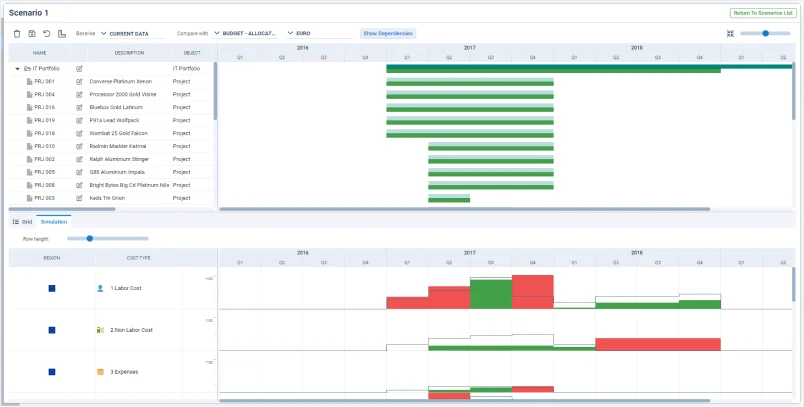
4. Use PPM tools with advanced resource management capabilities
PPM software is essential in any organization managing multiple projects or product portfolios. These tools not only enable centralized planning and tracking, but also facilitate real-time analysis, capacity management and resource forecasting.
These are some of the key features included in the best PPM software on the market:
- Comprehensive portfolio visibility: A PPM solution will give you real-time visibility into all ongoing projects and resource allocation. It will help you quickly identify where additional resources are needed or can be reallocated.
- Capacity Planning and Scenario Simulation: In the previous section we highlighted the importance of performing Scenario Simulations to plan resources in advance. Well, with PPM software you can simulate different scenarios not only of resource allocation, but also of other variables such as budgets, delivery times or prioritization.
- Integration with other management tools: in a hybrid management environment, it is essential that the PPM tool can be integrated with other management tools, whether for Agile or Waterfall teams. Thus, the solution needs to be able to integrate with Jira, Microsoft Project, Azure DevOps or SAP to facilitate access to all information.
- Customized reports and dashboards: with this type of tool you will have at your fingertips customized reports and dashboards with which Executives, IT managers, PMO and Project Managers will have a clear view of the status of resources and anticipate potential bottlenecks.
EBOOK
PPM Software Buyers’ Guide
What should you look for in a new PPM tool?
5. Foster collaboration between Agile and Waterfall teams
To overcome the challenges of managing projects in hybrid environments, Agile and Waterfall teams need to build bridges between them to facilitate collaboration and communication.
Here are some strategies you can put in place to foster collaboration:
- Foster a culture of transparency and mutual respect: fostering a culture where teams openly share their challenges, progress, and needs will help reduce misunderstandings and improve efficiency. Even though Agile and Waterfall teams work with such different methodologies, they should strive to find common ground to collaborate efficiently.
- Establish cross-functional teams: forming cross-functional teams that include profiles specialized in each management approach can help break down silos and improve collaboration.
- Create cross-functional communication processes: developing communication processes that span Agile and non-Agile teams is another strategy to consider. These processes can include shared collaboration tools (Google Drive, OneDrive), collaboration platforms (Teams, Slack, Miro) and procedures for information transfer and problem resolution.
6. Prioritize continuous communication
In line with the previous point, a communication strategy is key in project portfolio management, especially when Agile, Waterfall, and hybrid projects coexist. Without a clear strategy, misunderstandings will arise, conflicts in resource allocation will emerge, and ultimately, the likelihood of project failure will increase.
This communication strategy should cover the following aspects:
- Establish clear communication channels: Clear communication channels must be defined for coordination between teams. This includes digital tools such as the ones mentioned before (a PPM platform, Teams, Slack, etc.), as well as regular meetings.
- Implement follow-up meetings: Daily Scrum meetings or weekly reviews typical of Waterfall should be integrated to ensure all teams are aligned.
- Documentation and transparency: The documentation of all decisions and changes in projects should be clear and accessible from a single centralized repository.
7. Monitor and adjust resource plans frequently
And finally, you must continuously monitor and adjust resource plans to prevent teams from becoming overloaded or underutilized, which can lead to inefficiencies and missed delivery deadlines.
Here are some tips you can follow to adjust resource planning:
- Iterative capacity reviews: Adopting an iterative approach to capacity reviews allows for frequent adjustments to resource plans. This is particularly useful in scenarios where Agile projects may require quick adjustments based on sprint outcomes.
- Contingency planning: You should prepare contingency plans for resource allocation to ensure that projects can continue even when unexpected issues arise.
- Use of predictive tools: These tools, based on AI and Machine Learning, can help you anticipate potential capacity issues by offering recommendations on how to adjust resource planning.
Conclusion
Resource management in Agile and Waterfall projects presents unique challenges, especially in hybrid environments where both approaches coexist. Mastering these differences and overcoming the associated challenges is key to successful multi-project portfolio management.
By implementing the best practices described here, organizations can enhance their ability to manage resources effectively, optimize delivered value, and ensure the successful completion of projects, regardless of the methodology applied.
Master your resources across Agile and Waterfall Projects
Stop juggling spreadsheets! Get a free demo of Triskell and see how to streamline resource management for peak performance of project and product portfolios.
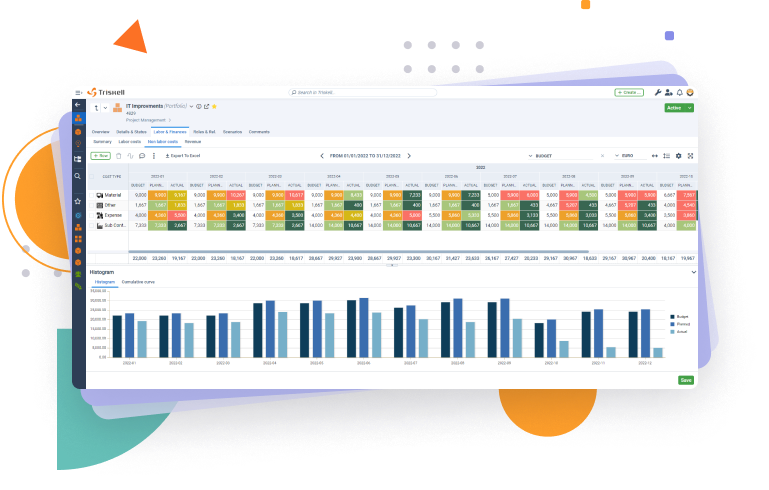
Related Content

How to create a project budget: methods and techniques for effective project budgeting
Learn how to create a project budget with this detailed guide. Discover essential methods and techniques for effective project budgeting in PPM.

20 strategic planning models and tools for medium and large companies
Looking for the best strategic planning frameworks? This guide covers 20 proven models to enhance decision-making and business growth.

The ultimate guide to Scenario Analysis for PPM: how it works, examples, techniques and tools
Master scenario analysis for PPM. Discover how to apply scenario planning for resource management, budgeting, and strategic decision-making.
FAQ about Resource Management in Agile and Waterfall projects
How do you handle resource dependencies when Agile and Waterfall teams are working together?
Resource dependencies between Agile and Waterfall teams require clear communication and a defined plan for synchronizing deliverables. Establish regular coordination meetings to align on timelines, and ensure dependencies are well-documented.
For instance, if an Agile team depends on a Waterfall deliverable, build flexibility into the Agile sprint to accommodate any delays. Using a shared collaboration tool to track progress across methodologies can also help teams anticipate and mitigate risks related to dependencies.
What tools can help improve resource management in a hybrid project management environment?
Using tools designed for Project Portfolio Management (PPM) is key in hybrid environments. These tools offer real-time resource tracking, scenario simulations, and dynamic capacity planning, allowing you to easily adjust resources as needed.
Some popular tools include Jira for Agile projects, Microsoft Project for Waterfall, and more integrated PPM tools like Triskell that bring all methodologies into one platform.
Look for tools that allow cross-methodology integration and reporting features to ensure smooth transitions between Agile and Waterfall needs.
What is the best approach for managing resources when transitioning from Waterfall to Agile methodologies?
Transitioning from Waterfall to Agile requires a shift in resource management practices. It’s important to first assess the skills and adaptability of your teams.
Agile emphasizes flexibility, cross-functional teams, and frequent adjustments, so resources must be trained in Agile principles and empowered to collaborate across different roles.
Additionally, start by applying Agile methodologies to smaller projects to allow teams to gradually adapt to more frequent iterations and dynamic planning, while still maintaining visibility over long-term goals.
